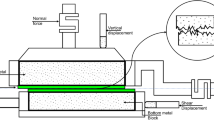Summary
Mechanisms for the dissipation of energy during the frictional sliding of rocks includes brittle fracture, plastic deformation, frictional heating, and elastic distortion. The first three energy sinks are manifested by surface damage during frictional sliding. Normal load, temperature, and the velocity of the sliding surfaces as well as surface roughness and hardness all influence the nature of surface damage which includes the generation of structures such as wear grooves, gouge, and welded particles.
Similar content being viewed by others
References
Archard, J. F. (1959),The temperature of rubbing surfaces, Wear2 438–455.
Arnold, G. W. (1952),Surface structure of quartz crystals, M.R.L. Rpt.4965, 15 pp.
Bowden, F. P. andThomas, P. H. (1954),The surface temperature of sliding solids, Roy. Soc. Lond. Proc223, 29–39.
Byerlee, J. D. (1967a),Theory of friction based on brittle fracture, Jour. Appl. Phys.38, 2928–2934.
Byerlee, J. D. (1967b),Frictional characteristics of granite under high confining pressure, J. Geophys. Res.72, 3639–3648.
Byerlee, J. D. (1970),Static and kinetic friction of granite at high normal stress, Int. J. Rock. Mech. Min. Sci.7, 577–582.
Byerlee, J. D., Mjachkin, V., Summers, R. andVoevoda, O. (1977),Structures developed in fault gouge during stable sliding and stick-slip, preprint.
Byerlee, J. andSummers, R. (1975),The effect of fault gouge on fault stability, preprint.
Coulson, J. H. (1970),The effects of surface roughness on the shear strength of joints in rock, Technical Report MRD-2-70, Missouri River Division, Corps of Engineers, Omaha, Neb., 283 pp.
Eirich, F. R. andTabor, D. (1948),Collisions through liquid films, Proc. Cambridge Phil. Soc.44, 566–580.
Engelder, J. T. (1974),Microscopic wear-grooves on slickensides: Indicators of paleoseismicity, J. Geophys. Res.79, 4387–4392.
Engelder, J. T.,Effect of scratch hardness on frictional wear and stick-slip of Westerly granite and Cheshire quartzite, in R. G. J. Strens (ed.), The Physics and Chemistry of Minerals and Rocks (Wiley, New York, 1976), 139–150.
Engelder, J. T. andMcKee, T. R. (1973),Electron microscopical study of indurated quartz gouges, Proc. Elect. Micro. Soc. Am. 31 st Ann. Mtg., 214–215.
Engelder, J. T., Logan, J. M. andHandin, J. (1975),The sliding characteristics of sandstone on quartz fault-gouge, Pure and Appl. Geophys.113, 68–86.
Engelder, J. T. andScholz, C. H. (1976),The role of asperity indentation and ploughing in rock friction, 2: Influence of relative hardness and normal load, Int. Jour. Rock Mech. Min. Sci.13, 155–163.
Friedman, M., Logan, J. M. andRigert, J. A. (1974),Glass indurated quartz gouge in sliding-friction experiments on sandstones, Bull. Geol. Soc. Am.85, 937–942.
Griggs, D. T. (1936),Deformation, of rocks under high confining pressures: 1. Experiments at room temperature, J. Geology,44, 541–577.
Humston, J. A.,Experimental study of stick-slip in Tennessee sandstone (M.S. thesis, 1972), Texas A and M University, College Station, 68 p.
Ishlinski, A. Y. andKreglskii, I. V. (1944),On stick-slip in friction, Zh. Teken. Fiz.,14, 276–282.
Jackson, R. E. andDunn, D. E. (1974),Experimental sliding friction and cataclasis of foliated rocks, Int Jour. Rock Mech. Min. Sci.11, 235–249.
Jaeger, J. C. (1942),Moving sources of heat and the temperature of sliding contacts, Proc. R. Soc. N.S.W.76, 203–224.
Jaeger, J. C. (1959),The frictional properties of joints in rocks, Geofis. Pura. Appl.43, 148–158.
Jeffreys, H. (1942),On the mechanics of faulting, Geol. Mag.79, 291–295.
Logan, J. M. andFriedman, M. (1976),Mechanical properties of rocks affecting earthquake prediction and control, 2nd Semi-annual Progress Report to the U.S. Geological Survey, Grant No. 14-08-0001-G-273 108 p.
Logan, J. andShimamoto, T. (1976),The influence of calcite gouge on the frictional sliding of Tennessee sandstone, EOS57, 1011.
Ohnaka, M. (1975),Frictional characteristics of typical rocks, J. Phys. Earth.23, 87–112.
McKenzie, D. andBrune, J. N. (1972),Melting on fault planes during large earthquakes, Geophys. J. Roy. astr. Soc.29, 65–78.
Scholz, C. H. andEngelder, J. T. (1976),The role of asperity indentation and ploughing in rock friction: 1. Asperity creep and stick-slip, Int. Jour. Rock Mech. Min. Sci.13, 149–154.
Teufel, L. W.,The measurement of contact areas and temperature during frictional sliding of Tennessee sandstone, (M.S. thesis, 1976) Texas A and M University, College Station, Texas, 65 p.
Tullis, J. andYund, R. A. (1977),Experimental deformation on dry Westerly granite, J. Geophys. Res., in press).
Author information
Authors and Affiliations
Additional information
Lamont-Doherty Geological Observatory Contribution No. 2620.
Rights and permissions
About this article
Cite this article
Engelder, T. Aspects of asperity-surface interaction and surface damage of rocks during experimental frictional sliding. PAGEOPH 116, 705–716 (1978). https://doi.org/10.1007/BF00876533
Received:
Issue Date:
DOI: https://doi.org/10.1007/BF00876533




